
Dasiphora fruticosa is a species of hardy deciduous flowering shrub in the family Rosaceae, native to the cool temperate and subarctic regions of the northern hemisphere, often growing at high altitudes in mountains. Dasiphora fruticosa is still widely referenced in the horticultural literature under its synonym Potentilla fruticosa. Common names include shrubby cinquefoil, golden hardhack, bush cinquefoil, shrubby five-finger, widdy, kuril tea and tundra rose.
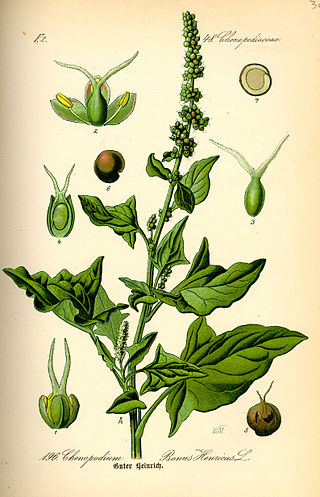
Blitum bonus-henricus, also called Good-King-Henry, poor-man's asparagus, perennial goosefoot, Lincolnshire spinach, Markery, English mercury, or mercury goosefoot, is a species of goosefoot which is native to much of central and southern Europe.
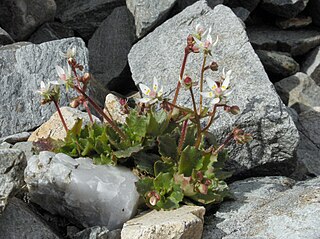
Micranthes stellaris, synonym Saxifraga stellaris, the starry saxifrage or hairy kidney-wort, is an Arctic–alpine species in the family Saxifragaceae. It produces panicles of 5–10 white flowers on a stem up to 20 cm (7.9 in) tall, rising from a basal leaf rosette. One subspecies is found from eastern Canada to Russia, including the British Isles, while another is found in the mountains of southern Europe.

Banksia dentata, commonly known as the tropical banksia, is a species of tree in the family Proteaceae. It occurs across northern Australia, southern New Guinea and the Aru Islands. Growing as a gnarled tree to 7 m (23 ft) high, it has large green leaves up to 22 cm (8.7 in) long with dentate margins. The cylindrical yellow inflorescences, up to 13 cm (5.1 in) high, appear between November and May, attracting various species of honeyeaters, sunbirds, the sugar glider and a variety of insects. Flowers fall off the ageing spikes, which swell and develop follicles containing up to two viable seeds each.

Rhodiola is a genus of perennial plants in the family Crassulaceae that resemble Sedum and other members of the family. Like sedums, Rhodiola species are often called stonecrops. Some authors merge Rhodiola into Sedum.

Galium boreale or northern bedstraw is a species of perennial flowering plant in the family Rubiaceae. It is widespread over the temperate and subarctic regions of Europe, Asia and North America including most of Canada and the northern United States.
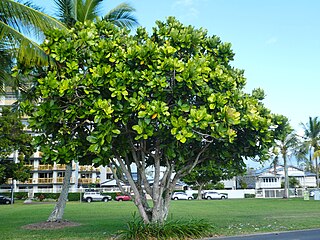
Barringtonia asiatica, also known as fish poison tree, putat or sea poison tree, is a species of Barringtonia native to mangrove habitats from islands of the Indian Ocean in the west to tropical Asia and islands of the western Pacific Ocean.

Plumeria obtusa, the Singapore graveyard flower, is a species of the genus Plumeria (Apocynaceae). It is native to the Neotropics, but widely cultivated for its ornamental and fragrant flowers around the world, where suitably warm climate exists.

Diplotaxis muralis, the annual wall-rocket, is a species of flowering plant in the family Brassicaceae. This plant is native to Europe, Asia, and Africa, but it is found throughout the temperate world, where it has naturalized. This is an erect mustard-like plant rarely reaching half a meter in height. It has lobed leaves and its stems are topped with dense inflorescences of yellow, or occasionally light purple, flowers with small oval petals and large anthers. The fruit is a podlike silique two to four centimeters long.

Lactuca saligna is a species of wild lettuce known by the common name willowleaf lettuce, and least lettuce. It is native to Eurasia but it grows in many other places as an introduced species, including much of North America.
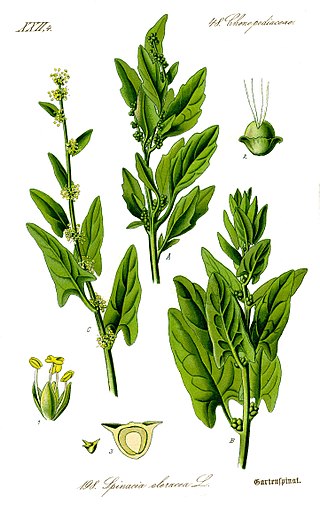
Spinacia is a flowering plant genus in the subfamily Chenopodioideae of the family Amaranthaceae. The most common member is spinach.
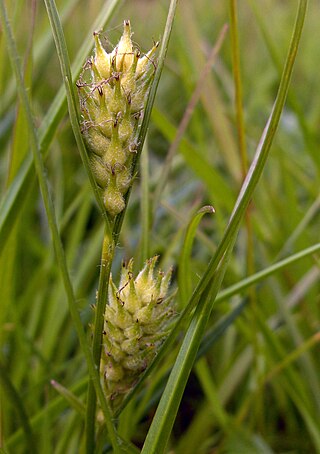
Carex hirta, the hairy sedge or hammer sedge, is a species of sedge native across Europe. It has characteristic hairy leaves and inflorescences, and is the type species of the genus Carex.

Phyllodoce caerulea, known as blue heath in British English and purple mountain heather or blue mountainheath in American English, is an evergreen species of dwarf shrub that grows up to around 15 cm (6 in) tall, and bears clusters of 2–6 purple flowers. It is native to boreal regions around the Northern Hemisphere, but with large gaps in its distribution.

Helleborus viridis, commonly called green hellebore, is a species of flowering plant in the buttercup family Ranunculaceae, native to Central and Western Europe, including southern England. All parts of the plant are poisonous.

Tordylium maximum, known as hartwort, is an annual or biennial flowering plant in the carrot family (Apiaceae).
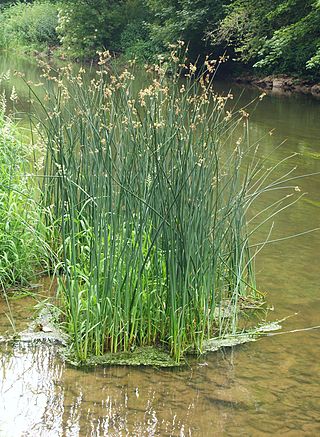
Schoenoplectus lacustris, the lakeshore bulrush or common club-rush, is a species of club-rush that grows in fresh water across Europe and some neighbouring areas.

Carex pulicaris, the flea sedge, is a species of sedge in the genus Carex native to Europe.

Scilla lilio-hyacinthus, the Pyrenean squill, is a species of flowering plant in the genus Scilla.

Scilla amoena, the star hyacinth or squill, is a species of flowering plant in the genus Scilla.

Ornithogalum broteroi, a species of the genus Ornithogalum, is a perennial bulbous flowering plant in the asparagus family (Asparagaceae). It is classed in the Cathissa group of the genus. It bears white flowers and usually a single leaf. It is found in open woods and pastures in the western part of the Iberian Peninsula and also Morocco.




















